The Economics and Statistics Division maintains archives of previous publications for accountability purposes, but makes no updates to keep these documents current with the latest data revisions from Statistics Canada. As a result, information in older documents may not be accurate. Please exercise caution when referring to older documents. For the latest information and historical data, please contact the individual listed to the right.
<--- Return to Archive
For additional information relating to this article, please contact:
August 10, 2018LABOUR MARKET TRENDS - JULY 2018 Nova Scotia's seasonally adjusted employment increased by 1,000 to 453,400 in July 2018. This increase follows back-to-back declines in seasonally adjusted employment. The employment level has remained over 450,000 since December 2017.
Compared to June, Nova Scotia’s labour force increased by 1,500 to 492,600 in July. With labour supply growing at a slightly faster pace than labour demand, the result was a 0.1 percentage point increase in the seasonally adjusted unemployment rate to 8.0 per cent in July. Nova Scotia’s unemployment rate remains below long run averages.
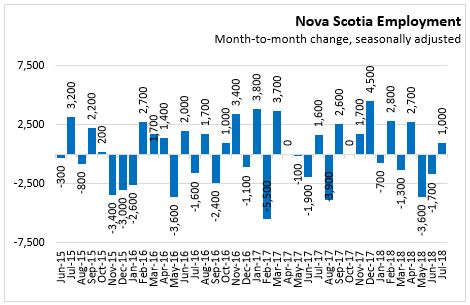
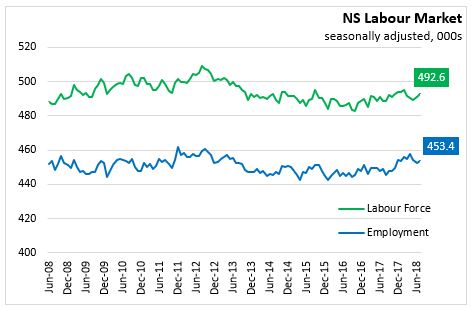
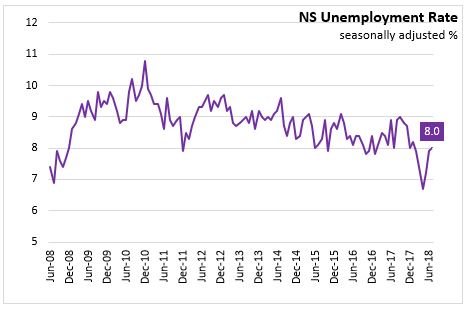
In July, the increase in employment was due to a gain in part-time employment (2,800) over riding the drop in full employment (-1,700). Although full time employment declined last month, it remains near record levels. Changes in part-time and full-time employment can include the net impacts of changing hours of work within the same position.
Year-to Date (January-July 2018 vs. January-July 2017)
Comparing the first seven months of 2018 to the same period in 2017, there was an increase of 5,600 (1.2 per cent) in the average employment level. Full time employment was up 9,500 (2.6 per cent) while there were 4,000 fewer part-time jobs (-4.7 per cent).
The labour force was up 2,500 (0.5 per cent) compared to the first seven months of 2017. With labour demand increasing at a faster pace, the net result was a drop in the average unemployment rate of 0.6 percentage point to 7.6 per cent. The labour force participation rate decreased by 0.2 percentage points to 61.7 per cent. The employment rate increased to 57.0 per cent.
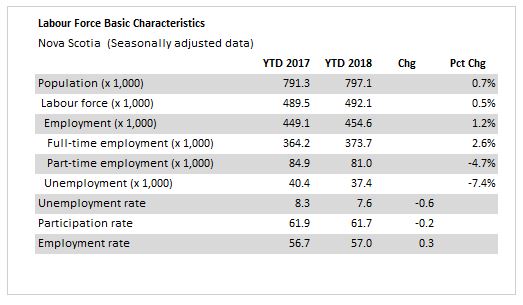
Age Cohorts
Comparing the first seven months of 2018 to the same period in 2017, the youth population (aged 15-24) saw a decrease in population (-600) and no change in employment while the labour force had an increase (400). With no change in labour demand and labour supply increasing, the unemployment rate for 15-24 year of age increased from 16.1 per cent in the first seven months of 2017 to 16.6 per cent in the first seven months of 2018. For July, the youth unemployment rate was 15.0 per cent.
Within the 25-54 age cohort, the population declined 700 over the first seven months of the year, but saw an employment increase of 4,300 and labour supply increase of 1,400. With employment increasing faster than the labour supply, there was a 1.0 per cent decline in the unemployment rate for this cohort, dropping to 6.0 per cent for the first seven months of 2018. The July unemployment rate for these core aged workers was 6.8 per cent.
The cohort aged 55 and older saw a population increase of 7,100 over the first months of last year, a labour force increase of 800 and employment gains of 1,300. With labour demand growing faster than the labour supply, there was a decrease in the unemployment rate to 6.5 per cent (compared to 6.9 per cent over the first seven months of 2017). The July unemployment rate for the age group 55 and older was 6.7 per cent.
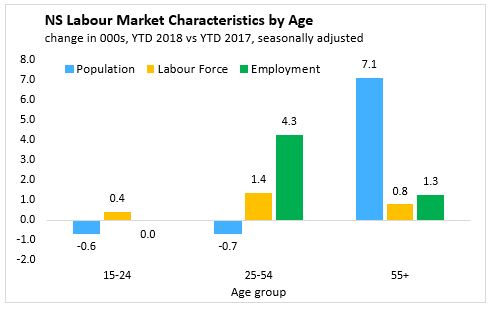
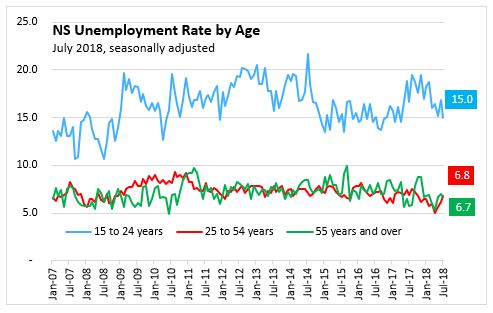
Sectors
Looking at public and private sector employees for the first seven months of 2018, the employment increase in private sector employees (6,300) was the driving force offsetting decreases in public sector employees (-3,400). For the same period self-employment was up 2,700.
Among goods-producing sectors, the first seven months of 2018 saw employment growth concentrated in manufacturing (+1,500) and construction (+1,300) offsetting declines in forestry, fishing, hunting, mining and oil and gas (-1,400). Services-producing employment increased by 3,300 for the first seven of 2018 over the same period in 2017. The largest increases come from education, accommodation/food sectors and wholesale/retail trade. The largest decline came from health care and social assistance.

Regions (3 month moving average, January-July 2018 vs. January-July 2017)
Comparing the 3-month average for the first seven months of 2018 with the same period in 2017, Halifax was the only region reporting a falling unemployment rate due to employment growth outpacing labour supply. The Southern region had lower unemployment rates due to labour supply falling while employment edged up. The North Shore region had falling employment and labour supply causing upward pressure on their unemployment rates. The Annapolis Valley and Cape Breton both reported no change in their unemployment rate with equal changes in both labour demand and labour supply. Cape Breton’s labour force and employment declined while the Annapolis Valley’s labour force and employment were growing.
The Cape Breton region reported a decline of 700 for both employment and labour force. These slight adjustments produced no change in the unemployment rate at 14.4 per cent.
For the North Shore region, employment decreased 2,200 while the labour force declined 2,300. The slightly stronger decline produced a 0.3 percentage point increase in the unemployment rate to 9.5 per cent.
The Annapolis Valley reported an increase of 500 for both employment and the labour force. The net result was no change in the average unemployment rate at 8.1 per cent.
The Southern region saw an increase of 800 in employment along with a drop of 900 in the labour force. With the labour force falling and employment increasing , the unemployment rate was down 2.9 percentage points to 7.4 per cent.
Halifax experienced an increase in employment of 7,600 along with an increase in the labour force of 6,700. With the labour demand growing faster than labour supply the unemployment rate dropped by 0.5 percentage point to 6.3 per cent in Halifax.
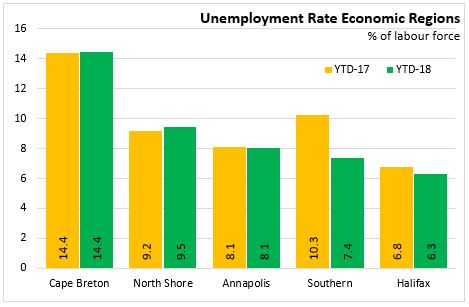
Provincial Comparisons
The Nova Scotia unemployment rate was 8.0 per cent in July 2018, the same level as a year ago. The Canadian unemployment rate was 5.8 per cent, down from 6.3 per cent one year ago. Compared to the same month one year ago, only New Brunswick, Manitoba and Saskatchewan reported a higher unemployment rate. Alberta had the steepest decline (-1.1 percentage points). The lowest unemployment rate among the provinces in July 2018 was in British Columbia (5.0 per cent) while the highest was in Newfoundland and Labrador at 15.4 per cent.
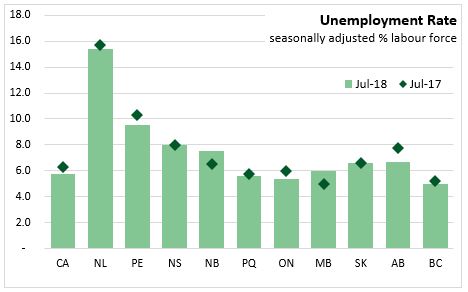
Comparing January-July 2018 with January-July 2017, employment increased 1.4 per cent in Canada. Employment grew in eight of the ten provinces, with the largest gains in Prince Edward Island (+2.6 per cent). Employment declined in Newfoundland and Labrador (-0.3 per cent) and Saskatchewan (-0.3 per cent).

National Comparisons: Cities
The seasonally adjusted unemployment rate for the Halifax Census Metropolitan Area (CMA) in July was 6.5 per cent. Peterborough (3.3 per cent) had the lowest unemployment rate among CMAs in July, while the highest was in St. John's (9.0 per cent).

The seasonally adjusted employment rate for the Halifax CMA was 63.9 per cent, down from 64.1 last month. Saguenay had the lowest employment rate (55.3 per cent), while Regina had the highest (67.8 per cent).
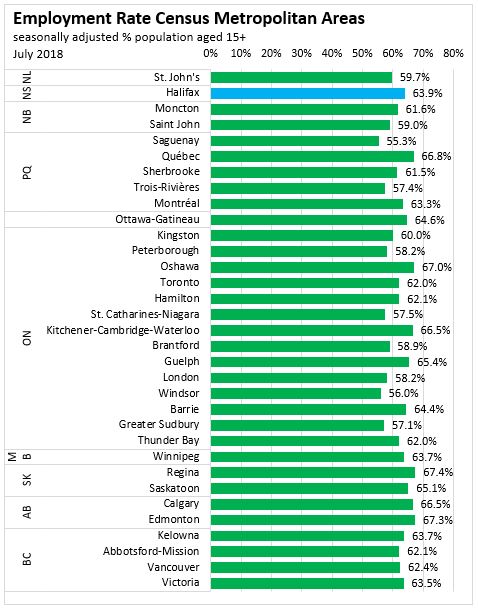
The three month average employment ending in July for the Halifax CMA was down 0.2 per cent compared to the three month period ending in June. The largest gain among CMAs was in Kitchener-Cambridge-Waterloo, Ontario, where employment rose by 2.3 per cent.

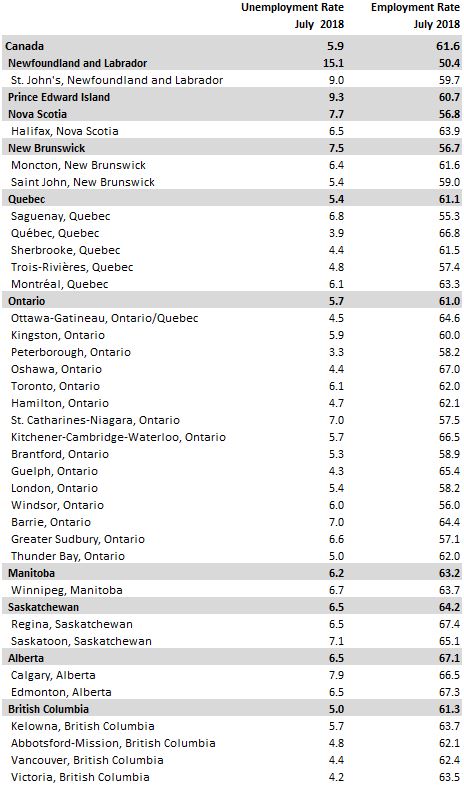
Note: Seasonally adjusted, 3 month average.
<--- Return to Archive